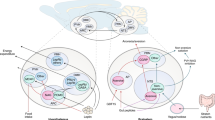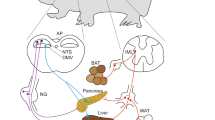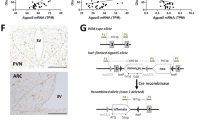Abstract
The brain regulates energy homeostasis by balancing energy intake, expenditure and storage. To accomplish this, it has evolved specialized neurons that receive and integrate afferent neural and metabolic signals conveying information about the energy status of the body. These sensor–integrator–effector neurons are located in brain areas involved in homeostatic functions such as the hypothalamus, locus coeruleus, basal ganglia, limbic system and nucleus tractus solitarius. The ability to sense and regulate glucose metabolism is critical because of glucose's primacy as a metabolic substrate for neural function. Most neurons use glucose as an energy substrate, but glucosensing neurons also use glucose as a signaling molecule to regulate neuronal firing and transmitter release. There are two types of glucosensing neurons that either increase (glucose responsive, GR) or decrease (glucose sensitive, GS) their firing rate as brain glucose levels rise. Little is known about the mechanism by which GS neurons sense glucose. However, GR neurons appear to function much like the pancreatic β-cell where glycolysis regulates the activity of an ATP-sensitive K+ (KATP) channel. The KATP channel is composed of four pore-forming units (Kir6.2) and four sulfonylurea binding sites (SUR). Glucokinase (GK) appears to modulate KATP channel activity via its gatekeeper role in the glycolytic production of ATP. Thus, GK may serve as a marker for GR neurons. Neuropeptide Y (NPY) and pro-opiomelanocortin (POMC) neurons in the hypothalamic arcuate nucleus are critical components of the energy homeostasis pathways in the brain. Both express Kir6.2 and GK, as well as leptin receptors. They also receive visceral neural and intrinsic neuropeptide and transmitter inputs. Such metabolism-related signals can summate upon KATP channel activity which then alters membrane potential, neuronal firing rate and peptide/transmitter release. The outputs of these neurons are integral components of effector systems which regulate energy homeostasis. Thus, arcuate NPY and POMC neurons are probably prototypes of this important class of sensor–integrator–effector neurons.
This is a preview of subscription content, access via your institution
Access options
Subscribe to this journal
Receive 12 print issues and online access
$259.00 per year
only $21.58 per issue
Buy this article
- Purchase on Springer Link
- Instant access to full article PDF
Prices may be subject to local taxes which are calculated during checkout
Similar content being viewed by others
Author information
Authors and Affiliations
Corresponding author
Rights and permissions
About this article
Cite this article
Levin, B. Glucosensing neurons do more than just sense glucose. Int J Obes 25 (Suppl 5), S68–S72 (2001). https://doi.org/10.1038/sj.ijo.0801916
Published:
Issue Date:
DOI: https://doi.org/10.1038/sj.ijo.0801916
Keywords
This article is cited by
-
The interplay between metabolic homeostasis and neurodegeneration: insights into the neurometabolic nature of amyotrophic lateral sclerosis
Cell Regeneration (2015)
-
Time-course Changes in Immunoreactivities of Glucokinase and Glucokinase Regulatory Protein in the Gerbil Hippocampus Following Transient Cerebral Ischemia
Neurochemical Research (2013)
-
Genes involved in obesity: Adipocytes, brain and microflora
Genes & Nutrition (2006)
-
Reward deficiency syndrome in obesity: A preliminary cross-sectional trial with a genotrim variant
Advances in Therapy (2006)
-
Role of hypothalamic 5′-AMP-activated protein kinase in the regulation of food intake and energy homeostasis
Journal of Molecular Medicine (2005)



